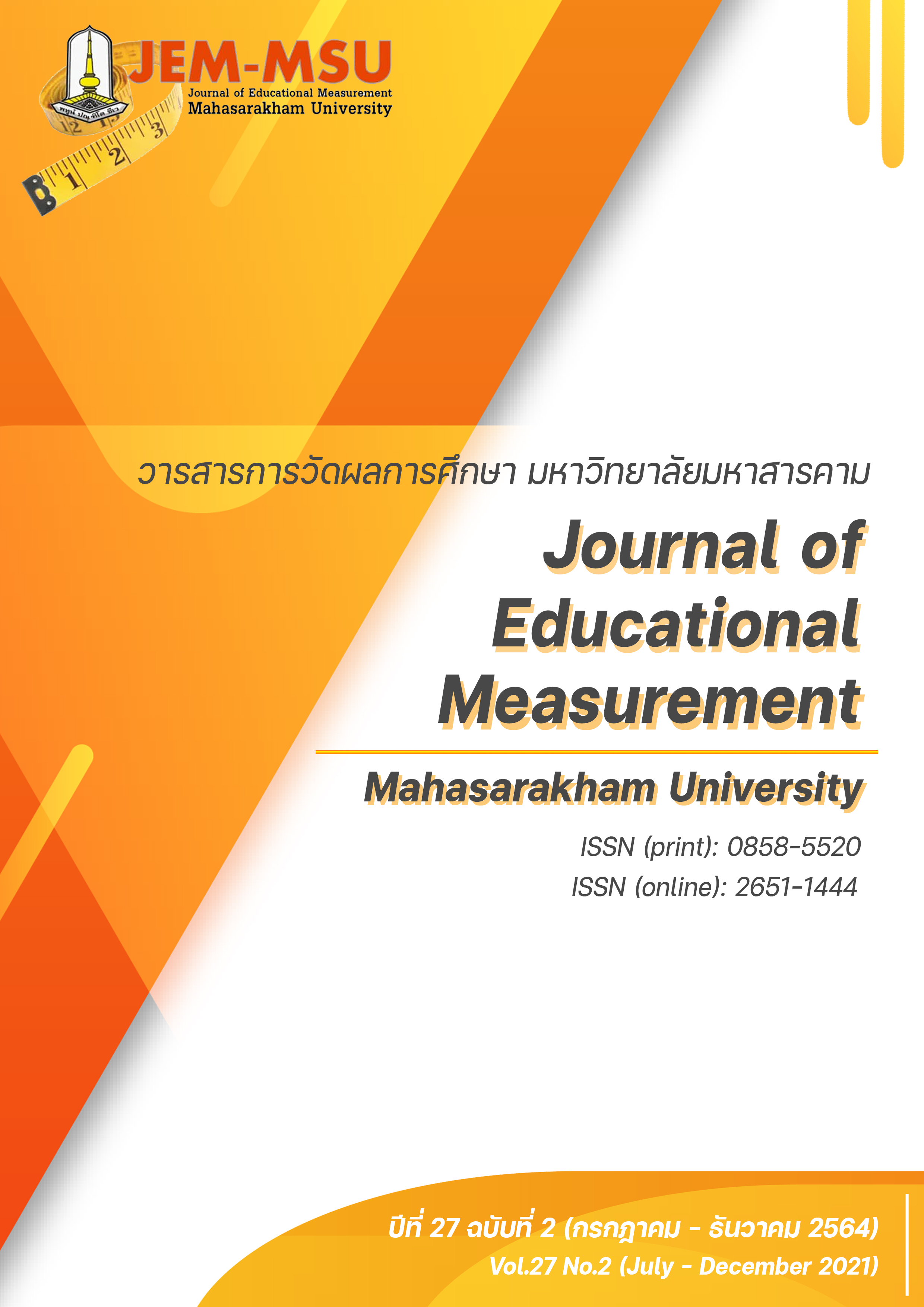A Comparison of Collaborative Problem-Solving Ability and Product Quality of Lower Secondary School Students Receiving Different Feedback Models
Main Article Content
Abstract
The objectives of this research were to 1) compare the collaborative problem-solving abilities of the lower secondary school students receiving different feedback models, 2) compare the pre-participation collaborative problem-solving abilities of lower secondary school students receiving different feedback models with their post-participation collaborative problem-solving abilities, after participating in collaborative problem-solving activities, and 3) compare the product qualities of the lower secondary school students receiving different feedback models. The research was a quasi-experiment research. The sample consisted of 42 lower secondary school students of Khongchai Wittayakom School in Khongchai District, Kalasin Province in the academic year 2019, selected through purposive sampling. The research instruments consisted of a collaborative problem-solving ability scale, a product quality evaluation form, collaborative problem-solving activities, a post-feedback note and feedback models. The feedback models were the Knowledge of Corrective Result Feedback: KCR, the Knowledge of Corrective Result and Directive Feedback: KCR+DF, and the Knowledge of Corrective Result and Elaborate Feedback: KCR+EF. The sample was divided into 3 groups, having 14 students with mixed ability of collaborative problem-solving in each group. Each group received all of the 3 feedback models in all of the 3 activities. The basic statistics for data analysis consisted of the mean, standard deviation, maximum and minimum values. The statistics used in hypothesis testing were Wilcoxon Matched Pairs Signed-Rank Test and Kruskal-Wallis Test.
The research findings were as follows:
1) The collaborative problem-solving abilities of the lower secondary school students in the same group but receiving different feedback models with different periods of time and different collaborative problem-solving activities, were not different. Also, the collaborative problem-solving abilities of the students of different groups, receiving different feedback models with the same periods of time and the same collaborative problem-solving activities, were not different.
2) The pre-participation collaborative problem-solving abilities of the lower secondary school students receiving different feedback models were different from their post-participation abilities after participating in collaborative problem-solving activities, with statistical significance at the .05 level.
3) The students receiving different feedback models had different product qualities, with statistical significance at the .05 level. The students receiving the Knowledge of Corrective Result and Elaborate Feedback (KCR+EF) had scores of product quality higher than those receiving the Knowledge of Corrective Result and Directive Feedback (KCR+DF) and the students receiving the Knowledge of Corrective Result Feedback (KCR), respectively.
Article Details
The content and information contained in the published article in the Journal of Educational Measurement Mahasarakham University represent the opinions and responsibilities of the authors directly. The editorial board of the journal is not necessarily in agreement with or responsible for any of the content.
The articles, data, content, images, etc. that have been published in the Journal of Educational Measurement Mahasarakham University are copyrighted by the journal. If any individual or organization wishes to reproduce or perform any actions involving the entirety or any part of the content, they must obtain written permission from the Journal of Educational Measurement Mahasarakham University.
References
กระทรวงศึกษาธิการ. (2553). ตัวชี้วัดและสาระการเรียนรู้แกนกลาง กลุ่มสาระการเรียนรู้วิทยาศาสตร์ ตามหลักสูตรแกนกลางการศึกษาขั้นพื้นฐาน พุทธศักราช 2551. กรุงเทพมหานคร: โรงพิมพ์ชุมนุมสหกรณ์การเกษตรแห่งประเทศไทย จำกัด.
กติกร กมลรัตนะสมบัติ. (2558). ผลของการให้ข้อมูลย้อนกลับจากแบบสอบอัตนัยประยุกต์ที่มีต่อพัฒนาการความสามารถในการแก้ปัญหาทางคณิตศาสตร์ของนักเรียนระดับมัธยมศึกษา. วิทยานิพนธ์ปริญญาครุศาสตรมหาบัณฑิต. จุฬาลงกรณ์มหาวิทยาลัย.
กมลฉัตร กล่อมอิ่ม. (2559). การพัฒนาการจัดการเรียนรู้แบบบูรณาการสะเต็มศึกษาเพื่อส่งเสริมความสามารถในการคิดวิเคราะห์สำหรับนักเรียนชั้นประถมศึกษา. มหาวิทยาลัยราชภัฏเพชรบูรณ์: เพชรบูรณ์.
จรูญพงษ์ ชลสินธุ์. (2559). การวิจัยปฏิบัติการเพื่อพัฒนาการจัดการเรียนรู้ตามแนวสะเต็มศึกษาที่เน้นกระบวนการออกแบบเชิงวิศวกรรมที่ส่งเสริมสมรรถนะการแก้ปัญหาแบบร่วมมือ เรื่อง ปริมาณสารสัมพันธ์. วิทยานิพนธ์ปริญญาการศึกษามหาบัณฑิต. คณะศึกษาศาสตร์ มหาวิทยาลัยนเรศวร.
จำรัส อินทลาภาพร และคณะ. (2558). การศึกษาแนวทางการจัดการเรียนรู้ตามแนวสะเต็มศึกษาสำหรับผู้เรียนระดับประถมศึกษา. วารสารวิชาการ Veridian E-Journal, 8(1), 61-73.
ดาวเรือง ลุมทอง และโชติกา ภาษีผล. (2553). ผลของรูปแบบข้อมูลย้อนกลับที่มีต่อพัฒนาการของผลงานด้านทัศนศิลป์: การประยุกต์ใช้ข้อมูลย้อนกลับทั่วไปและข้อมูลชี้แนะเพื่อการปรับปรุง. วารสารอิเล็กทรอนิกส์ทางการศึกษา, 6(1), 353-367
พรศรี ลีทวีกุลสมบูรณ์. (2539). การเลือกรับข้อมูลย้อนกลับในบทเรียนคอมพิวเตอร์ช่วยสอนและผลสัมฤทธิ์ทางการเรียนวิชาภาษาอังกฤษของผู้เรียนชั้นมัธยมศึกษาปีที่ 3 ที่มีเพศและระดับผลสัมฤทธิ์ทางการเรียนแตกต่างกัน. วิทยานิพนธ์ปริญญามหาบัณฑิต. จุฬาลงกรณ์มหาวิทยาลัย.
วรรณี แกมเกตุ. (2551). วิธีวิทยาการวิจัยทางพฤติกรรมศาสตร์. กรุงเทพฯ : โรงพิมพ์แห่งจุฬาลงกรณ์มหาวิทยาลัย.
สสวท. (2561). การแก้ปัญหาแบบร่วมมือ (Collaborative Problem Solving) บทสรุปสำหรับผู้บริหาร. สถาบันส่งเสริมการสอนวิทยาศาสตร์และเทคโนโลยี. พิมพ์เผยแพร่ 17 หน้า
สมเกียรติ ตั้งกิจวานิชย์. (2556). การจัดทำยุทธศาสตร์การปฏิรูปการศึกษาขั้นพื้นฐานให้เกิดความรับผิดชอบ. กรุงเทพฯ: สถาบันวิจัยเพื่อการพัฒนาประเทศไทย.
สุกัญญา นิมานันท์. (2533). ข้อมูลย้อนกลับในบทเรียนคอมพิวเตอร์ช่วยสอน. วารสารวิทยบริการจุฬาลงกรณ์มหาวิทยาลัย, 12(1), 22-28.
อนงค์ เมธีพิทักษ์ธรรม. (2555). ผลของรูปแบบการให้ข้อมูลย้อนกลับที่แตกต่างกันที่มีต่อความสามารถในการแก้ปัญหาทางคณิตศาสตร์ของผู้เรียนระดับมัธยมศึกษาปีที่ 1. วิทยานิพนธ์ปริญญาครุศาสตรมหาบัณฑิต. จุฬาลงกรณ์มหาวิทยาลัย.
Duncan, N. (2007). Feed-forward: improving student use of tutors’comments. Assessment & Evaluation in Higher Education, 32(3), 271-283.
Goldsmith, M. (2002). Leadership Development: Try feedforward instead of feedback. Journal of Excellence, 25(8), 15-19
Heilenman, L. K. (1990). Self –assessment of second Language ability: The role of response effect. Language testing, 7(2), 174-201.
Irons, A. (2008). Enhancing learning through formative assessment and feedback. NewYork: Routledge.
Ministry of Education. (2008). Core curriculum for basic education curriculum 2008. Bangkok: Ministry of Education. OECD. (2013a). PISA 2015: Draft collaborative problem solving framework. Paris: OECD.


